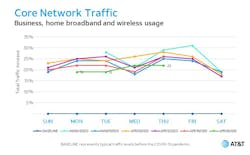After signs that the growth in bandwidth demand due to coronavirus stay-at-home mitigation efforts may have plateaued (see “Broadband demand growth approaching a plateau, suggests OpenVault”), Verizon indicated May 6 that its networks have seen a lessening in demand for some services. The service provider cites the reopening of businesses and the loosening of restrictions in some states as well as “spring weather” as catalysts for the demand decline. AT&T's statistics also show an easing of demand. However, other indices still showed slight gains.
Verizon says that several of the bellwether services whose popularity has spiked during the pandemic have seen traffic declines. They include video streaming (-11% week-over-week), gaming (-4%), and the use of collaboration tools (-5%). Meanwhile, Fios On Demand movie viewership was only 3% higher this past weekend than the pre-pandemic average. Verizon said it had seen a peak increase in on-demand viewing of 68% in March.
Conversely, mobile service handoffs – instances where a data session moves from one cell site to another as users travel – had increased 6.2% over the past week, the largest jump since the COVID-19 pandemic began. The only regions that didn’t see an increase during the last week were Upstate New York, New England, and the Great Plains, indicating that mobile subscribers in other regions were beginning to leave their homes and move around more. Nevertheless, daily handoff averages remained 18% lower than typical, Verizon said.
“The network performance numbers definitely indicate a break in routines people have formed over the last several weeks during the pandemic,” said Kyle Malady, CTO for Verizon. “As more restrictions are lifted and people begin resuming normal activities, we expect to see these changes continue. Our network team has been working 24x7 since this crisis began to ensure we were able to meet the shifting demands as the virus took hold. We will continue to monitor and respond to changing needs as life adjusts on the other side of this.”
AT&T, meanwhile, posted the chart below on its website, which indicates that core network traffic demands may be easing. Even so, they remained either 19% or 22% greater than what AT&T considers "a similar day at the end of February."
But elsewhere, demand still grows.
However, not all operators have seen such declines during the past week. The NCTA’s “COVID-19: How Cable's Internet Networks Are Performing” page which aggregates data from such NCTA members as Altice, CableOne, Charter, Comcast, Cox, GCI, Mediacom, Midco, and Sjoberg's, showed a slight week-on-week growth in both peak upstream and downstream bandwidth demand – although so little that the NCTA called peak bandwidth demand “flat.” Upstream demand increased 0.1%, while downstream demand ticked upward by 2.1%.
Overall, peak upstream demand among reporting members has grown by 34.3% since March 1, while peak downstream demand has climbed 16.2%, NCTA reports.
For related articles, visit the FTTx Topic Center.
For more information on FTTx technology and suppliers, visit the Lightwave Buyer’s Guide.
To stay abreast of fiber network deployments, subscribe to Lightwave’s Service Providers and Datacom/Data Center newsletters.
About the Author

Stephen Hardy
Editorial Director and Associate Publisher, Lightwave
Stephen Hardy is editorial director and associate publisher of Lightwave and Broadband Technology Report, part of the Lighting & Technology Group at Endeavor Business Media. Stephen is responsible for establishing and executing editorial strategy across the both brands’ websites, email newsletters, events, and other information products. He has covered the fiber-optics space for more than 20 years, and communications and technology for more than 35 years. During his tenure, Lightwave has received awards from Folio: and the American Society of Business Press Editors (ASBPE) for editorial excellence. Prior to joining Lightwave in 1997, Stephen worked for Telecommunications magazine and the Journal of Electronic Defense.
Stephen has moderated panels at numerous events, including the Optica Executive Forum, ECOC, and SCTE Cable-Tec Expo. He also is program director for the Lightwave Innovation Reviews and the Diamond Technology Reviews.
He has written numerous articles in all aspects of optical communications and fiber-optic networks, including fiber to the home (FTTH), PON, optical components, DWDM, fiber cables, packet optical transport, optical transceivers, lasers, fiber optic testing, and more.
You can connect with Stephen on LinkedIn as well as Twitter.

